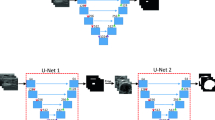Abstract
The early detection of breast tumors is a critical concern for healthcare professionals, including oncologists and radiologists. While Artificial Intelligence (AI) has demonstrated potential in early breast cancer diagnosis, the efficacy of these models is often constrained by the limited size and lack of diversity in medical training sets. Although data augmentation techniques are explored to enlarge and enhance training sets, many such methods neglect the crucial aspect of sample diversity, leading to suboptimal tumor identification. Among the prevalent data augmentation techniques, the MixUp method is commonly employed to increase the size and diversity of data sets. However, its application in ultrasound image enhancement can introduce extraneous noise and may result in the loss of vital image features. This paper presents a novel data augmentation strategy termed Cluster and MixUP (Cluster MixUP) Augmentation, designed to enrich the diversity of training data while retaining essential image features. The approach combines K-means clustering with the MixUp Augmentation technique to group and mix images effectively. The efficacy of the proposed strategy is validated using the Breast Ultrasound Images database (BUSI), demonstrating superior performance and generalizability in breast cancer detection relative to existing data augmentation methods.
Access this chapter
Tax calculation will be finalised at checkout
Purchases are for personal use only
Similar content being viewed by others
References
Agrawal, T., Choudhary, P.: Segmentation and classification on chest radiography: a systematic survey. Vis. Comput. 39(3), 875–913 (2023)
Al-Dhabyani, W., Gomaa, M., Khaled, H., Aly, F.: Deep learning approaches for data augmentation and classification of breast masses using ultrasound images. Int. J. Adv. Comput. Sci. Appl. 10(5), 1–11 (2019)
Alblwi, A., Baksh, M., Barner, K.E.: Bone age assessment based on salient object segmentation. In: 2021 IEEE International Conference on Imaging Systems and Techniques (IST), pp. 1–5. IEEE (2021)
Alblwi, A., Barner, K.E.: Optimizing feature representation via a nested network for object segmentation. In: 2022 8th International Conference on Optimization and Applications (ICOA), pp. 1–6. IEEE (2022)
Alblwi, A., Barner, K.E.: Ultrasound image segmentation via multi-scale salient network (2024), under submission
Badrinarayanan, V., Kendall, A., Cipolla, R.: Segnet: a deep convolutional encoder-decoder architecture for image segmentation. IEEE Trans. Pattern Anal. Mach. Intell. 39(12), 2481–2495 (2017)
Cao, W., Chen, H.D., Yu, Y.W., Li, N., Chen, W.Q.: Changing profiles of cancer burden worldwide and in china: a secondary analysis of the global cancer statistics 2020. Chin. Med. J. 134(07), 783–791 (2021)
Chen, C., Chuah, J.H., Ali, R., Wang, Y.: Retinal vessel segmentation using deep learning: a review. IEEE Access 9, 111985–112004 (2021)
Dai, P., Dong, L., Zhang, R., Zhu, H., Wu, J., Yuan, K.: Soft-cp: a credible and effective data augmentation for semantic segmentation of medical lesions. arXiv preprint arXiv:2203.10507 (2022)
Fahad Ullah, M.: Breast cancer: current perspectives on the disease status. In: Breast Cancer Metastasis and Drug Resistance: Challenges and Progress, pp. 51–64 (2019)
Li, J.P.O., et al.: Digital technology, tele-medicine and artificial intelligence in ophthalmology: a global perspective. Prog. Retin. Eye Res. 82, 100900 (2021)
Michael, E., Ma, H., Li, H., Kulwa, F., Li, J.: Breast cancer segmentation methods: current status and future potentials. Biomed. Res. Int. 2021, 1–29 (2021)
Nalepa, J., Marcinkiewicz, M., Kawulok, M.: Data augmentation for brain-tumor segmentation: a review. Front. Comput. Neurosci. 13, 83 (2019)
Nemoto, T., et al.: Effects of sample size and data augmentation on u-net-based automatic segmentation of various organs. Radiol. Phys. Technol. 14, 318–327 (2021)
Oktay, O., et al.: Attention u-net: learning where to look for the pancreas. arXiv preprint arXiv:1804.03999 (2018)
Ronneberger, O., Fischer, P., Brox, T.: U-net: convolutional networks for biomedical image segmentation. In: Navab, N., Hornegger, J., Wells, W.M., Frangi, A.F. (eds.) MICCAI 2015. LNCS, vol. 9351, pp. 234–241. Springer, Cham (2015). https://doi.org/10.1007/978-3-319-24574-4_28
Sims, R., et al.: A pre-clinical assessment of an atlas-based automatic segmentation tool for the head and neck. Radiother. Oncol. 93(3), 474–478 (2009)
Sun, X., et al.: Robust retinal vessel segmentation from a data augmentation perspective. In: Fu, H., et al. (eds.) Ophthalmic Medical Image Analysis. OMIA 2021. LNCS, vol. 12970, pp. 189–198. Springer, Cham (2021). https://doi.org/10.1007/978-3-030-87000-3_20
Wang, Y., Ji, Y., Xiao, H.: A data augmentation method for fully automatic brain tumor segmentation. Comput. Biol. Med. 149, 106039 (2022)
Zhang, H., Cissé, M., Dauphin, Y.N., Lopez-Paz, D.: mixup: beyond empirical risk minimization. arXiv preprint arXiv:1710.09412 (2017)
Author information
Authors and Affiliations
Corresponding author
Editor information
Editors and Affiliations
Rights and permissions
Copyright information
© 2024 The Author(s), under exclusive license to Springer Nature Singapore Pte Ltd.
About this paper
Cite this paper
Alblwi, A., Mehmood, N., Labombard, J., Barner, K.E. (2024). A Data Augmentation Approach to Enhance Breast Cancer Segmentation. In: Su, R., Zhang, YD., Frangi, A.F. (eds) Proceedings of 2023 International Conference on Medical Imaging and Computer-Aided Diagnosis (MICAD 2023). MICAD 2023. Lecture Notes in Electrical Engineering, vol 1166. Springer, Singapore. https://doi.org/10.1007/978-981-97-1335-6_14
Download citation
DOI: https://doi.org/10.1007/978-981-97-1335-6_14
Published:
Publisher Name: Springer, Singapore
Print ISBN: 978-981-97-1334-9
Online ISBN: 978-981-97-1335-6
eBook Packages: Computer ScienceComputer Science (R0)




